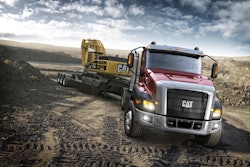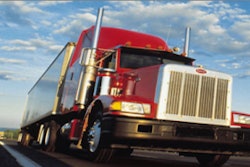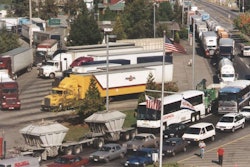Dana Holding Corp. on Tuesday, March 22, announced the company’s lineup of fuel-efficient integrated drivetrain systems for construction and material-handling on display this week at CONEXPO-CON/AGG 2011 in Las Vegas, Nev. Headlining the show for Dana is the introduction of the first hydromechanical variable transmission (HVT) system resulting from a cooperative effort between Dana and Bosch Rexroth AG.
“The rising price of fuel, combined with more stringent emissions regulations, has made fuel consumption a top concern for the construction industry,” says Pietro Franzosi, vice president of business development for the Dana Off-Highway Products Group. “At Dana, our integrated systems approach and commitment to research and development have produced numerous drivetrain solutions that help original-equipment manufacturers more effectively address the ever-growing demand for fuel efficiency.”
Located in booth S-17915 of the South Hall at the Las Vegas Convention Center, Dana will present a complete 20-ton front-end loader system featuring the new HVT, as well as a driveline system for nine- to 10-ton industrial lift trucks.
The HVT at CONEXPO -CON/AGG is part of a 20-ton (18-tonne) front-end loader drivetrain system that also includes the Spicer Hercules 37R axle and Spicer Model 114 axle. Dana and Bosch Rexroth says short Y-cycle simulations of front-end loaders equipped with the new HVT demonstrate fuel savings of more than 20 percent when compared to the same vehicle outfitted with a conventional torque converter transmission.
Targeted for use on front-end loaders, graders, forestry skidders and other off-highway applications requiring 115 to 360 horsepower (90-270 kW), the HVT is designed to improve productivity by enabling sensitive, precise vehicle positioning and stepless drive with no interrupted acceleration. It occupies the same space within the design envelope as conventional torque converter transmissions while allowing for engine downsizing. The HVT is designed to optimize the operating point of the diesel engine by decoupling engine speed from drive speed, and maintenance costs are reduced by utilizing hydrostatic braking and wear-free directional reversals.
Engineered with a rigid, modular load-bearing structure including the differential carrier, housing arms, high-energy wet brakes and planetary wheel ends, the Spicer Hercules 37R axle accommodates multiple vehicle platform configurations. Spicer 37R axles are available with Posi-Torq and Hydraloc differential designs designed to provide excellent torque bias performance in a wide range of ground traction conditions. Using large multiplate clutch discs actuated by gear-separating forces, the Posi-Torq design provides a 45-percent locking capacity, resulting in up to 72-percent torque transfer to the high-traction wheel.
As an operator-controlled differential, the Hydraloc design for 37R series axles allows for moment-to-moment lock-and-release control, delivering added ground torque bias in severe traction conditions. In its unlocked condition, the Hydraloc differential permits free vehicle steering to facilitate maximum maneuverability. Once locked, a hydraulic piston applies force to a large multiplate wet clutch, resulting in up to 100-percent torque transfer to the high-traction wheel.
The Spicer Model 114 drive axle includes a limited-slip differential lock that provides a 45-percent locking capacity, delivering added tractive force and vehicle steering for front-end loader applications. The axle can be configured with a variety of other hydraulic-locking differential options, including dog clutch and multidisc clutch.
Inboard wet disc brakes offer added stopping performance and energy absorption, while a fail-safe park brake featuring internal negative SAHR is available as an option. The Spicer Model 114 and 37R axles incorporate 6.00-to-1 ratio outboard planetary wheel ends with 425 mm wheel bolt-circle mountings, self-adjusting internal wet brakes and a trunnion mounting option.
The Dana driveline system for nine- to 10-ton (eight- to nine-tonne) industrial lift trucks includes the Spicer TE08 powershift transmission and the new Spicer Model 139 axle – the latest in a line of axles specifically designed for industrial lift trucks – as well as a Spicer Life Series Model 150 driveshaft.
Rated at 75 to 110 horsepower (55 to 82 kW), the Spicer TE08 transmission offers three forward and two reverse speeds, while two-speed forward systems also are available. By using a multiple-speed design, the TE08 transmission is designed to deliver improved overall transmission power transfer over single-speed transmissions equipped with less efficient twin-turbine torque converters. The TE08 features a reduced transmission length and output drop, helical gears for noise reduction and an integral engine pump drive to power system hydraulics.
The TE08 transmission uses a fully electronically modulated clutch control with proportional solenoids. Full electronic modulation and its associated control systems enable OEMs to use a complete range of best-in-class controls, such as safety inhibits, diagnostics, system monitoring, load- and speed-compensated automatic shifting, shift overlap control, electronic inching and automatic throttle up. The Spicer Model 139 axle is engineered to handle the highest load capacities while offering the same durability, reliability and ease of maintenance provided by Spicer Model 137 and 138 axles already used for smaller lift trucks.
Suitable for lift trucks equipped with pneumatic tires, the Spicer Model 139 axle includes integral frame and mast mounting provisions for fixed-mast lift truck applications, and its spiral bevel center section and a 6-to-1 planetary ratio generate 13-to-1 through 17-to-1 overall axle ratios. The Spicer Model 139 axle has a planetary design that allows for a small ring gear, enabling engineers to locate the mast as close to the axle’s center line as possible for optimum geometry in load carrying and lifting.












